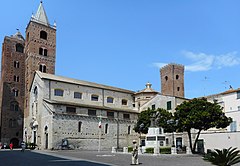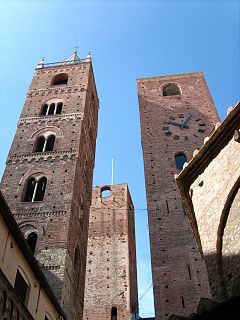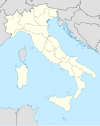Albenga Cathedral

Albenga Cathedral (Italian: Cattedrale di San Michele Arcangelo, Duomo di Albenga) is a

A church has occupied the site since the turn of the 4th to the 5th century, but the present structure is medieval, built in about 1100, with a major rebuilding in the second half of the 12th century, and another in 1582. A restoration project in the 1970s largely returned the building to the medieval structure. The bell tower was rebuilt in its present form in the 1390s.
The
The cathedral interior is well stocked with sculptures and works of art. The 19th century ceiling frescos are by Maurizio and Tommaso Carrega. Other frescos, particularly those in the apse, are of the 15th century. The right hand nave contains a fresco by the artist
The cathedral also owns two paintings of the late 14th century by Luca Baudo of
Name
Name All the written documentation in our possession assigns the title of the Cathedral of ingauna to St. Michael the Archangel. A tradition has it that on the road that leads from Albenga to Alassio there was a snake that killed anyone who passed. The population made a procession praying to St. Michael the Archangel to kill the snake. During the night a glow was seen coming from the sky and heading towards a point on the road; the population rushed in, and found the snake killed.
The protection of San Michele was widespread in the Lombards period, when the people in arms invoked the Saint and to whose effigy they swore fidelity before the fight. However, the proliferation of the cult dates back to the Byzantine era, and at the time the city of Albenga had close commercial relations with the Byzantine Empire, so the title of the cathedral to San Michele can place us at its first building.
However, documents emerged for which it was thought that for some time it could have been attributed to San Giovanni: the first document dates back to 1076 and dealt with the sale of a mill, in which the presence of eleven Sancti Iohannis milites is mentioned. The document by which the bishop of Albenga donated churches in the surroundings of Porto Maurizio to the
Albenga had its name linked to that of military saints, from Saint Calocero to Martin of Tours, but also in the church of St. George, or in the findings of the church of St. Teodoro, since the fortifications built by Costanzo created a city militarized in the Byzantine period.
History
Located in the center of the medieval city of Albenga, the foundation of the original building of worship date back to the reconstruction of the city (between the 4th and early 5th centuries), in the center of the Roman city. It stands on the site with the exact dimensions of the early Christian one. Its rebuilding occurred around 1100, on the ruins of the early Christian church, and again in the second half of the 20th century.
According to tradition, in the road that leads from
The first plant

An early study of ancient plant
Thanks to the division of Liguria in
Structure
The cathedral is today divided into a nave and two
The various structural stages that followed are clearly visible in the outside

References
Sources and external links
- Diocese of Albenga-Imperia website Archived 2009-02-28 at the Wayback Machine (in Italian)
- SBAPGE website: Albenga Cathedral (in Italian)
- Provincia Savona website: Cattedrale di San Michele (in Italian)




